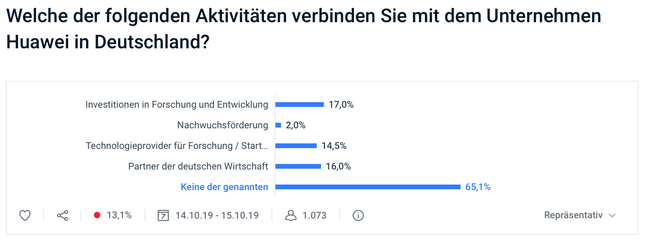
by Hubertus Hofkirchner -- Vienna, 15 Oct 2019
I just came across the below example of a traditional, "frequentist" approach to brand perception research using the questionnaire method on Civey's public platform. So I finally write up a beef I have with traditional questionnaire research, and its (usually unintended) manipulation of respondents' minds by answer options offered or omitted or simply missed.

For Non-German speakers: The question translates to "Which of the following activities do you connect with the company Huawei in Germany?" The most frequent answer: "Keine der genannten" translates to "None of the above". As we can see 65.1% of respondents tick this answer, four times (!) those who select the first specific answer "R&D Investments" at 17.0%. Clearly, Huawei will never know from this exercise what "other" activity German-speakers really connect with its brand. Mind, this is Huawei, a well-known player in that market.
I notice this same issue with many frequentist project types, with particularly bad effects in conjoint analysis. There, if you miss one or more (unknown) decision factors your expensive project will give you wrong clues for your new product development. Usually, you will never know any better, as frequentist research answers are rarely falsifiable. Karl Popper would have called them "metaphysical".
So, how can we go about this problem? Easy: Just re-formulate you research question into a "proper" prediction question and obtain the answers implicitly. Any traditional reputation score can be the fulcrum of your prediction question, the KPI to be predicted. Set up a "conditional" prediction question on a prediction market platform of your choice: "What (reputation score) will Huawei achieve in (prediction horizon)?" (Naturally, I recommend Prediki's own platform.)
After you entered this question title, summarise the most recent real-world reputation score result in the questions' wiki article, this roots them in reality. If you want, you can even provide them with a short, one sentence teaser on your woking hypothesis on potential reputation-enhancing activities. Then broaden their perspective by asking the same question for one or two of your key competitors. Note that the answers to these questions are strictly falsifiable: At the specified future point in time, actual reputation scores will become available. Hence, participants in this exercise must think harder than in traditional questionnaire which pays tor their time.
All set. Now just send in your crowd. After they enter their virtual trade to win the incentive, they will hype it in the qualitative market talk just like brokers in the real stock market. They will dig deep into their minds to come up with arguments for their sentiment with anything which may convince the others. Prediki's inbuilt-semantic analysis tool can then extract from their talk which activity or previously unknown factor moved the market most, i.e. correspond to convincing predictions.
So, problem solved: Never again will you get a research result and be none the wiser about the most important point.
- Back to the Management by Predictions Blog
- Follow this blog for more stories, new case studies and how-to's.

